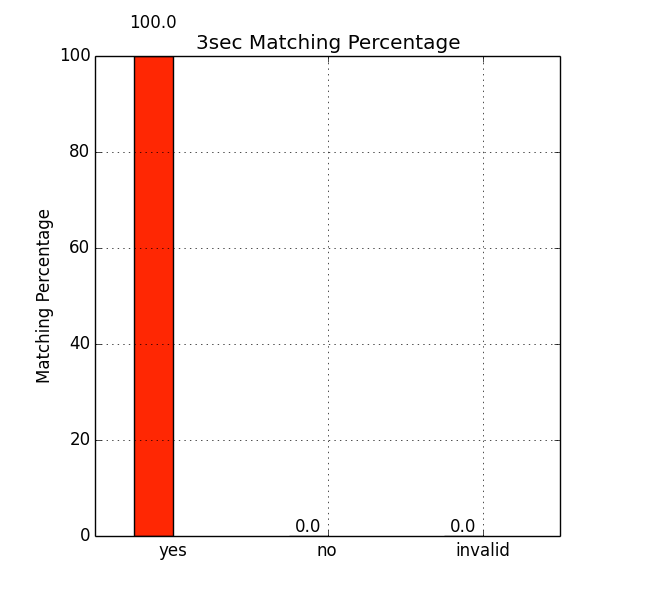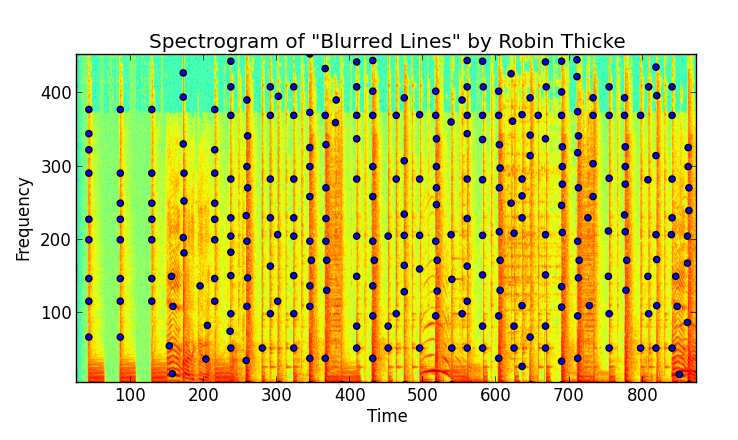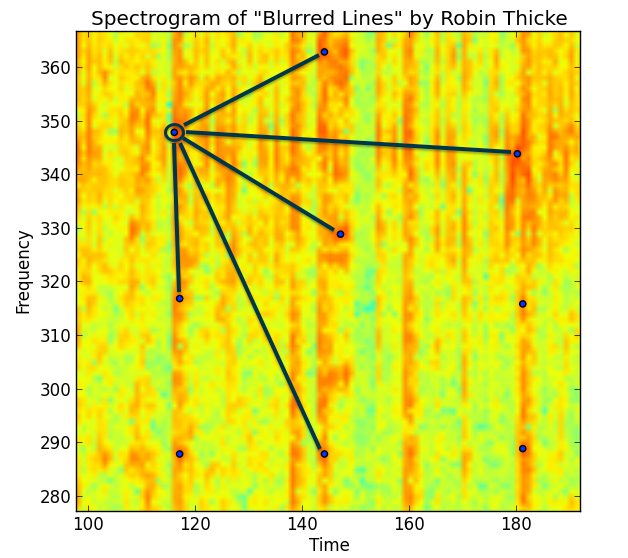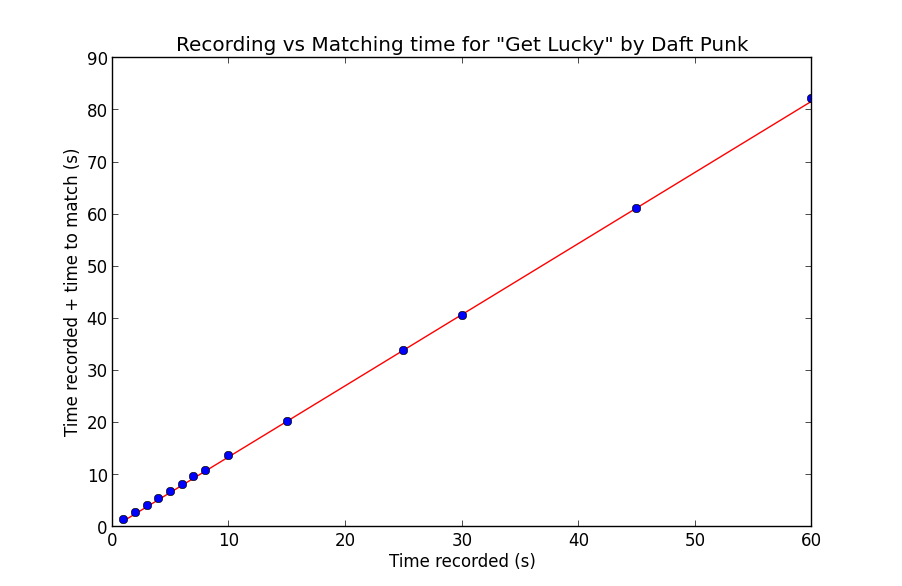This fork attempts to:
- [:heavy_check_mark:] Fix bugs (fixes critical numpy one).
- [:heavy_check_mark:] Use SQLAlchemy to support PostgreSQL, SQLite3 DBs as well.
- [:heavy_check_mark:] Use Pipenv to allow db credentials via .env file
- [:heavy_check_mark:] Support both Python3 and Python2.
- [:heavy_check_mark:] Use the logging module so as to not litter any user's application with prints.
- [:heavy_check_mark:] Reformat code using YAPF (Facebook)
- [:heavy_check_mark:] Implement simple HTTP REST interface
- [:heavy_check_mark:] Implement simple websocket interface
- Install directly from this repo:
pip install -e git+https://github.com/ivlovric/dejavu@1.3.4#egg=PyDejavu
- Import and use:
from dejavu import Dejavu
from dejavu.recognize import FileRecognizer
djv = Dejavu(dburl='sqlite://')
djv.fingerprint_directory('~/Music')
song = djv.recognize(FileRecognizer, 'mp3/Dura--Daddy-Yankee.mp3')
print(song)- Can also be used as a CLI tool:
export DATABASE_URL=mysql+mysqlconnector://bryan:password@localhost/dejavu
python dejavu.py --fingerprint ~/Music mp3 --limit 30
python dejavu.py --recognize mic 10
python dejavu.py --recognize file sometrack.mp3
python dejavu.py --network http
python dejavu.py --network ws
For network usage, default HTTP port is 4141 and WS is 4242
Examples:
HTTP
curl --location --request POST 'http://localhost:4141/upload' \
--header 'Content-Type: application/octet-stream' \
--data-raw 'ID3\x03\x00\x00\x00\x026_APIC\x00\x00c\xdf\x00\x00\x01image/jpg\x00\x03\xff\xfeS\x00e\x00a\x00n\x00 \x00F\x00o\x00u\x00r\x00n\x00i\x00e\x00r\x00 \x00:\x00 \x00O\x00h\x00 \x00M\x00y\x00\x00\x00\xff\xd8\xff\xe0\x00\x10JFIF\x00\x01\x01\x01\x00d\x00d\x00\x00\xff\xdb\x00C\x00\x08\x06\x06\x07\x06\x05\x08\x07\x07\x07\t\t\x08\n\x0c\x14\r\x0c\x0b\x0b\x0c\x19\x12\x13\x0f\x14\x1d\x1a\x1f\x1e\x1d\x1a\x1c\x1c $.\'\'' ",#\x1c\x1c(7),01444\x1f\'\''9=82<.342\xff\xdb\x00C\x01\t\t\t\x0c\x0b\x0c\x18\r\r\x182!\x1c!22222222222222222222222222222222222222222222222222\xff\xc0\x00\x11\x08\x01\x90\x01\
curl --location --request POST 'http://localhost:4141/upload' \
--header 'Content-Type: application/octet-stream' \
--form 'file=@"/somepath/Josh-Woodward--I-Want-To-Destroy-Something-Beautiful.mp3"'```
>WS
Send encoded bytes. There is one Simple WS client in devavu/ws_client.py that can be used to test
```python3 ws_client.py```
You can keep the database url saved in an .env file and use pipenv. As
well as specify it via the `--dburl` command line argument.
**NOTE** Some incompatibility around byte encoding is present with this connector pair
for some database versions (e.g. [MariaDb](https://mariadb.org/)).
Consider using `mysql+pymysql` instead of `mysql+mysqlconnector` with a simple
fingerprint to check for this error.
## Migrating from worldveil/dejavu
If you already have a live database that used to follow worldveil/dejavu
database structure, you'll have to migrate your database
by renaming:
* `song_id` to `id`
* `song_name` to `name`
in the `songs` table.
## Testing
We have included a `docker-compose.yml` and Dockerfile that allows 'headless' testing.
### Build container
You can choose the Python version you wish to build with by setting:
export PYTHON_VERION=3.6.6
Or update the Pipfile with the version you want and use:
export PYTHON_VERSION=$(cat Pipfile | awk '/python_version/ {print $3}' | tr -d '"')
Then run the build:
docker-compose build
This creates a `dejavu` container.
### Test with docker-compose
Once the container is built, you can run your tests:
docker-compose run dejavu pipenv run run_tests
This will run the script called `run_tests` in the `Pipfile`
You can get a shell with:
docker-compose run dejavu /bin/bash
You can then run tests inside the container with either `pipenv run run_tests` or `bash test_dejavu.sh`
You can change the default command the container/service will run by changing the `CMD` in the `Dockerfile` or `command` in the `docker-compose.yml` file.
Currently they are set to `tail -f /dev/null` which basically keeps a process running in the container without doing anything.
You may want to set these to `pipenv run run_tests` for testing. See [Docker](https://docs.docker.com/engine/reference/builder/#cmd) or [docker-compose](https://docs.docker.com/compose/compose-file/#command)
## Tuning
Inside `config/settings.py`, you may want to adjust following parameters (some values are given below).
FINGERPRINT_REDUCTION = 30
PEAK_SORT = False
DEFAULT_OVERLAP_RATIO = 0.4
DEFAULT_FAN_VALUE = 5
DEFAULT_AMP_MIN = 10
PEAK_NEIGHBORHOOD_SIZE = 10
These parameters are described within the file in detail. Read that in-order to understand the impact of changing these values.
## Recognizing
There are two ways to recognize audio using Dejavu. You can recognize by reading and processing files on disk, or through your computer's microphone.
### Recognizing: On Disk
Through the terminal:
```bash
$ python dejavu.py --recognize file sometrack.wav
{'total_time': 2.863781690597534, 'fingerprint_time': 2.4306554794311523, 'query_time': 0.4067542552947998, 'align_time': 0.007731199264526367, 'results': [{'song_id': 1, 'song_name': 'Taylor Swift - Shake It Off', 'input_total_hashes': 76168, 'fingerprinted_hashes_in_db': 4919, 'hashes_matched_in_input': 794, 'input_confidence': 0.01, 'fingerprinted_confidence': 0.16, 'offset': -924, 'offset_seconds': -30.00018, 'file_sha1': b'3DC269DF7B8DB9B30D2604DA80783155912593E8'}, {...}, ...]}
or in scripting, assuming you've already instantiated a Dejavu object:
>>> from dejavu.logic.recognizer.file_recognizer import FileRecognizer
>>> song = djv.recognize(FileRecognizer, "va_us_top_40/wav/Mirrors - Justin Timberlake.wav")With scripting:
>>> from dejavu.logic.recognizer.microphone_recognizer import MicrophoneRecognizer
>>> song = djv.recognize(MicrophoneRecognizer, seconds=10) # Defaults to 10 seconds.and with the command line script, you specify the number of seconds to listen:
$ python dejavu.py --recognize mic 10Testing out different parameterizations of the fingerprinting algorithm is often useful as the corpus becomes larger and larger, and inevitable tradeoffs between speed and accuracy come into play.
Test your Dejavu settings on a corpus of audio files on a number of different metrics:
- Confidence of match (number fingerprints aligned)
- Offset matching accuracy
- Song matching accuracy
- Time to match
An example script is given in test_dejavu.sh, shown below:
#####################################
### Dejavu example testing script ###
#####################################
###########
# Clear out previous results
rm -rf ./results ./temp_audio
###########
# Fingerprint files of extension mp3 in the ./mp3 folder
python dejavu.py --fingerprint ./mp3/ mp3
##########
# Run a test suite on the ./mp3 folder by extracting 1, 2, 3, 4, and 5
# second clips sampled randomly from within each song 8 seconds
# away from start or end, sampling offset with random seed = 42, and finally,
# store results in ./results and log to ./results/dejavu-test.log
python run_tests.py \
--secs 5 \
--temp ./temp_audio \
--log-file ./results/dejavu-test.log \
--padding 8 \
--seed 42 \
--results ./results \
./mp3The testing scripts are as of now are a bit rough, and could certainly use some love and attention if you're interested in submitting a PR! For example, underscores in audio filenames currently breaks the test scripts.
The algorithm works off a fingerprint based system, much like:
The "fingerprints" are locality sensitive hashes that are computed from the spectrogram of the audio. This is done by taking the FFT of the signal over overlapping windows of the song and identifying peaks. A very robust peak finding algorithm is needed, otherwise you'll have a terrible signal to noise ratio.
Here I've taken the spectrogram over the first few seconds of "Blurred Lines". The spectrogram is a 2D plot and shows amplitude as a function of time (a particular window, actually) and frequency, binned logrithmically, just as the human ear percieves it. In the plot below you can see where local maxima occur in the amplitude space:
Finding these local maxima is a combination of a high pass filter (a threshold in amplitude space) and some image processing techniques to find maxima. A concept of a "neighboorhood" is needed - a local maxima with only its directly adjacent pixels is a poor peak - one that will not survive the noise of coming through speakers and through a microphone.
If we zoom in even closer, we can begin to imagine how to bin and discretize these peaks. Finding the peaks itself is the most computationally intensive part, but it's not the end. Peaks are combined using their discrete time and frequency bins to create a unique hash for that particular moment in the song - creating a fingerprint.
For a more detailed look at the making of Dejavu, see my blog post here.
To truly get the benefit of an audio fingerprinting system, it can't take a long time to fingerprint. It's a bad user experience, and furthermore, a user may only decide to try to match the song with only a few precious seconds of audio left before the radio station goes to a commercial break.
To test Dejavu's speed and accuracy, I fingerprinted a list of 45 songs from the US VA Top 40 from July 2013 (I know, their counting is off somewhere). I tested in three ways:
- Reading from disk the raw mp3 -> wav data, and
- Playing the song over the speakers with Dejavu listening on the laptop microphone.
- Compressed streamed music played on my iPhone
Below are the results.
Reading from disk was an overwhelming 100% recall - no mistakes were made over the 45 songs I fingerprinted. Since Dejavu gets all of the samples from the song (without noise), it would be nasty surprise if reading the same file from disk didn't work every time!
Here I wrote a script to randomly chose n seconds of audio from the original mp3 file to play and have Dejavu listen over the microphone. To be fair I only allowed segments of audio that were more than 10 seconds from the starting/ending of the track to avoid listening to silence.
Additionally my friend was even talking and I was humming along a bit during the whole process, just to throw in some noise.
Here are the results for different values of listening time (n):
This is pretty rad. For the percentages:
| Number of Seconds | Number Correct | Percentage Accuracy |
|---|---|---|
| 1 | 27 / 45 | 60.0% |
| 2 | 43 / 45 | 95.6% |
| 3 | 44 / 45 | 97.8% |
| 4 | 44 / 45 | 97.8% |
| 5 | 45 / 45 | 100.0% |
| 6 | 45 / 45 | 100.0% |
Even with only a single second, randomly chosen from anywhere in the song, Dejavu is getting 60%! One extra second to 2 seconds get us to around 96%, while getting perfect only took 5 seconds or more. Honestly when I was testing this myself, I found Dejavu beat me - listening to only 1-2 seconds of a song out of context to identify is pretty hard. I had even been listening to these same songs for two days straight while debugging...
In conclusion, Dejavu works amazingly well, even with next to nothing to work with.
Just to try it out, I tried playing music from my Spotify account (160 kbit/s compressed) through my iPhone's speakers with Dejavu again listening on my MacBook mic. I saw no degredation in performance; 1-2 seconds was enough to recognize any of the songs.
On my MacBook Pro, matching was done at 3x listening speed with a small constant overhead. To test, I tried different recording times and plotted the recording time plus the time to match. Since the speed is mostly invariant of the particular song and more dependent on the length of the spectrogram created, I tested on a single song, "Get Lucky" by Daft Punk:
As you can see, the relationship is quite linear. The line you see is a least-squares linear regression fit to the data, with the corresponding line equation:
1.364757 * record_time - 0.034373 = time_to_match
Notice of course since the matching itself is single threaded, the matching time includes the recording time. This makes sense with the 3x speed in purely matching, as:
1 (recording) + 1/3 (matching) = 4/3 ~= 1.364757
if we disregard the miniscule constant term.
The overhead of peak finding is the bottleneck - I experimented with multithreading and realtime matching, and alas, it wasn't meant to be in Python. An equivalent Java or C/C++ implementation would most likely have little trouble keeping up, applying FFT and peakfinding in realtime.
An important caveat is of course, the round trip time (RTT) for making matches. Since my MySQL instance was local, I didn't have to deal with the latency penalty of transfering fingerprint matches over the air. This would add RTT to the constant term in the overall calculation, but would not effect the matching process.
For the 45 songs I fingerprinted, the database used 377 MB of space for 5.4 million fingerprints. In comparison, the disk usage is given below:
| Audio Information Type | Storage in MB |
|---|---|
| mp3 | 339 |
| wav | 1885 |
| fingerprints | 377 |
There's a pretty direct trade-off between the necessary record time and the amount of storage needed. Adjusting the amplitude threshold for peaks and the fan value for fingerprinting will add more fingerprints and bolster the accuracy at the expense of more space.





